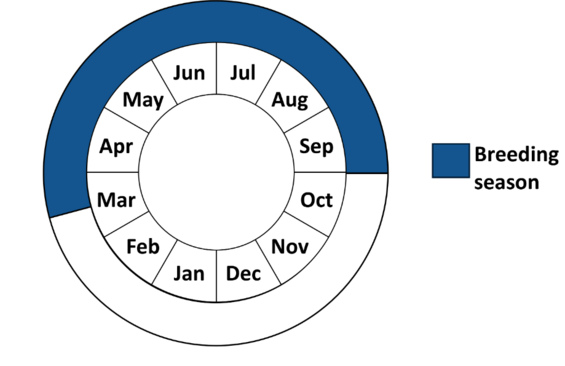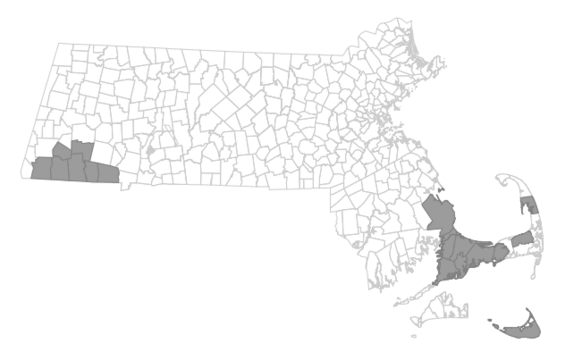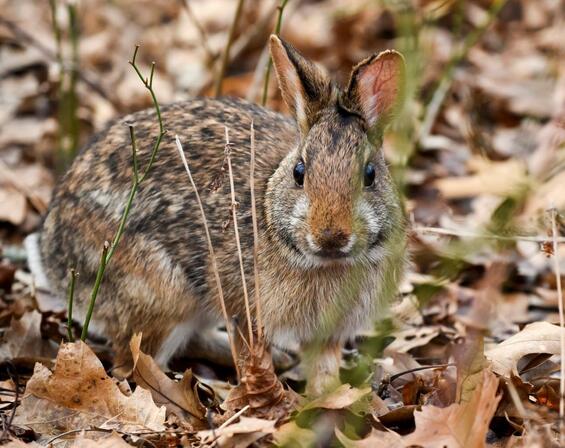- Scientific name: Sylvilagus transitionalis
- Species of Greatest Conservation Need (MA State Wildlife Action Plan)
Description
New England cottontail (Sylvilagus transitionalis)
The New England cottontail is a medium-sized cottontail rabbit with dark brown to buffy upper parts overlain with distinct black guard hairs. Their ears are short, rounded, and typically substantially furred. Adult New England cottontails weigh approximately 1 kg (2.2 lb) and measure 38–43 cm (15–17 in) in length. Cranial characteristics (skull features), including an irregular suture between the frontals and nasals, a long slender postorbital process (rarely touching the skull), and the absence of a pronounced supraorbital process, can reliably distinguish New England cottontail from the similar in appearance and sympatric eastern cottontail (S. floridanus).
Life cycle and behavior
New England cottontails are most active at dawn and dusk. In spring and summer, they eat grasses and herbaceous plants, while in the winter they rely on bark, twigs, and buds. New England cottontails can be reluctant to forage in the open and prefer the cover of thickets. The average lifespan of a New England cottontail is 2 to 3 years in the wild. They breed between March and September. After a 4-week gestation period, they give birth to 3–8 kits (5 on average). They often have multiple litters per year, where they mate almost immediately after giving birth. Young rabbits mature rapidly and become independent at 4–5 weeks old. Some will breed during their first year.

This graphic represents the peak timing of life events for New England cottontail in Massachusetts. Variation may occur across individuals and their range.
Population status
Currently, the abundance and distribution of New England cottontail has been stable since the early 2000s, though geographically limited to portions of southeastern Massachusetts and southern Berkshire County.

Distribution in Massachusetts. 2000–2024. Based on Litvaitis survey and regional monitoring.
Distribution and abundance
New England cottontail is currently known to occur in isolated populations within parts of Connecticut, Maine, Massachusetts, New Hampshire, Rhode Island, and New York east of the Hudson River. Historically, they were likely distributed throughout Massachusetts in areas of suitable habitat. However, by the 1930s their range began to decline and by 1990, they were found in only 6 of the 14 counties. Eastern cottontail (S. floridanus), which were widely introduced throughout Massachusetts and stocked as a game species during the first half of the 1900s, were found in 13 of 14 counties by 1990. Currently, New England cottontail are known to exist in areas of southeastern Massachusetts (including Nantucket) and in southern Berkshire County.
Habitat
The New England cottontail is an early successional or thicket-dwelling species. They remain active year-round in habitat patches of sufficient size with dense woody understory consisting of young trees and shrubs that provide both food and cover. Suitable habitat for New England cottontail consists of regenerating young forest stands, shrublands reverting to young forest, and forested wetlands typically with dense understory vegetation. They have been documented using young forest stands created through the use of silvicultural clearcutting. In addition, they occupy areas where natural disturbance has removed canopy trees and a dense woody understory has developed. High stem density ecosystems are necessary to provide critical protection from predators and provide ample food resources, particularly in winter.
Healthy habitats are vital for supporting native wildlife and plants. Explore habitats and learn about conservation and restoration in Massachusetts.

Threats
Many factors have influenced the general decline of New England cottontail over the past century. The widespread loss of early successional habitat types through forest maturation has significantly contributed to the rabbit’s decline. Continued residential and commercial development has also fragmented, degraded, or contributed to the loss of habitat and connectivity for New England cottontail.
Eastern cottontail, which is now present throughout the range of New England cottontail, is not native to eastern New York or New England. They were released as a game species in the region during the early half of the 1900s. Within the last half of the 1900s, an increase in the range of eastern cottontail coincided with a decrease in the range of New England cottontail. This may have led to the decline of our native rabbit in areas where the species both occur.
Conservation
The New England Cottontail Conservation Initiative was formed in 2009 as a collaboration between state and federal natural resource agencies, non-governmental organizations, land trusts, universities, and private landowners, with a goal of conserving the New England cottontail throughout the species' current range. The New England Cottontail Technical Committee implements objectives contained in the New England Cottontail Conservation Strategy (2012). Efforts of the Technical Committee include a zoo-based conservation rearing program, establishment of island colonies, use of breeding pens, and prioritizing research and monitoring.
New England cottontail is monitored annually through a regional effort associated with the New England Cottontail Technical Committee. Surveys are conducted to determine their presence/absence and occupancy status on roughly 30–35 sites within occupied habitat in southern Berkshire County and southeastern Massachusetts. Fecal pellets are collected annually, typically from January to mid-March, for DNA analysis. Additional efforts by university partners are also under way to determine abundance of New England cottontail in occupied patches and viability of meta-populations.
Since 2011, over 17,000 acres of habitat have been managed to benefit New England cottontails across the region on private and public land. As of 2025, Massachusetts private landowners have voluntarily participated in managing almost 700 acres of habitat, primarily in the southern Berkshires, and nearly 300 acres have been managed on state, federal, land trust, and tribal properties on Cape Cod. In addition, the Natural Resources Department at Joint Base Cape Cod actively manages habitat.
New England Cottontail conservation partners are contending with the presence of eastern cottontail by evaluating the adverse effects and how to minimize them. Eastern cottontail utilize similar habitats as New England cottontail and may compete for resources or interfere with breeding. Additional research is needed to quantify the negative impacts eastern cottontail has on the recovery of New England cottontail.
A variety of research needs have been identified by the New England Cottontail Technical Committee, but currently research is focused on evaluating meta-population dynamics and viability. Since rabbits are relatively dispersal limited yet live primarily in discrete patches of suitable and often ephemeral habitat, understanding meta-populations dynamics is critical to prioritize conservation actions and resources into meaningful landscapes for New England cottontail.
References
Arbuthnot, M. A Landowner’s Guide to New England Cottontail Habitat Management. Environmental Defense Fund. (2008): 36 pp.
Fuller, S. and Tur, A. "Conservation Strategy for the New England Cottontail (Sylvilagus transitionalis)." (2012) US Fish & Wildlife Publications. 320.
Litvaitis, J.A. “Response of early successional vertebrates to historic changes in land use.” Conservation Biology 7 (1993): 866-873.
Litvaitis, J.A., M.N. Marchand, J.P. Tash, M. Oberkrieser, V. Johnson, and M.K. Litvaitis. Interim progress report II: a regional inventory of New England cottontails. Departments of Natural Resources and Zoology, University of New Hampshire, Durham, New Hampshire (2003): 37pp.
Smith, D.F., and J.A. Litvaitis. “Foraging strategies of sympatric lagomorphs: implications for differential success in fragmented landscapes.” Canadian Journal of Zoology 78 (2002): 2134-2141.
Contact
| Date published: | May 1, 2025 |
|---|